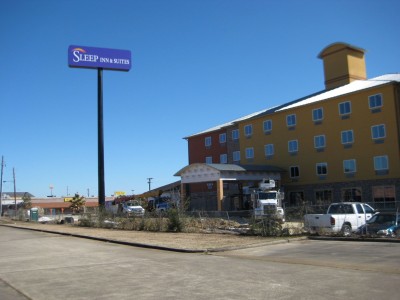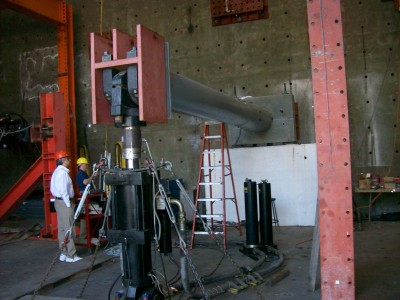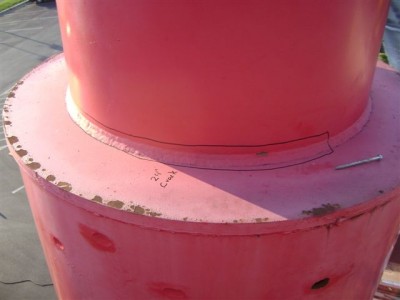Recommendations to prevent structural failure
by Matthew | 13 May 2012 11:08 am
 [1]
[1]Photos courtesy ISA
By Bill Dundas
The International Sign Association (ISA) recently released the results from a three-year study of single-pole ‘high-rise’ sign structures. Conducted by the department of structural engineering at the University of California, San Diego (UCSD), the study involved researching the causes of sporadic failures of high-rising sign structures that incorporate ‘telescoping’ poles composed of multiple sections.
Through 2010 and 2011, UCSD’s Charles Lee Powell Structural Systems Laboratory performed fatigue tests on a series of specimens with various types of connections for single-pole steel sign structures. The findings provide conceptual guidance for structural designers in the repair and rebuilding of existing signs, as well as for improving the safety and durability of newly built structures.
Structural studies
Free-standing high-rise sign structures—i.e. those that rise 15 m (50 ft) or more above grade—have become an essential tool for many commercial and retail businesses in marketing their locations to customers. Many are installed near major highways and are supported by single poles with a telescoping configuration.
In recent years, ISA’s technology and research committee became aware of concerns about a few of these signs falling due to unknown causes. As there was little data about these incidents, conflicting theories arose regarding the possible causes. So, ISA commissioned an independent engineering analysis by UCSD to help shed more light on the issue.
 [2]
[2]UCSD’s test setup used a hydraulic actuator, with the sign structure specimen bases bolted to a concrete retaining wall.
UCSD completed an initial study in 2008 that evaluated the common sleeve connections of these cantilevered steel sign structures. It found substantial forces could be imposed, under certain wind conditions, on the welded connections between the structures’ segments. Specifically, the study suggested these types of structures, regardless of their age, are vulnerable to fatigue cracks at their telescoping connection points, due to wind-induced vibration.
The ISA committee then developed guidelines in concert with UCSD and other industry experts to help identify risk profiles and inspection procedures. These guidelines were widely disseminated within the industry and to sign users. Meanwhile, further engineering evaluations were undertaken at UCSD’s lab.
A second study, based on fatigue tests of various designs, was completed in October 2011. This study validated the need for regular inspections of all sign structures and also helped suggest improved design approaches. The study found certain types of structural repairs could offer substantial improvements over some of the methods that had been used in the past. The aim was to detect all structural issues, then foster the development of ‘best practices’ guidelines that could be applied across the sign industry.
UCSD tested various splice connections for cantilevered steel sign structures to evaluate their relative fatigue resistance, using different types of connection details for both newly constructed and retrofitted or repaired single-pole signs. A total of 17 specimens were evaluated this way, both to establish a baseline and to compare alternatives.
Specifically, the baseline was determined by testing four specimens featuring commonly used lap-splice connections, with or without a guide ring. (Some designs specify a second ring-shaped plate, which fits inside the lower pipe section, while other designs specify only a single, internal plate.) The other specimens included five repaired with various combinations of welded gussets, grout, steel cones or jackets and fibreglass-reinforced polymer (FRP) composites, along with eight using alternative connection details.
The assumption behind the testing was the greater the difference in fatigue resistance or durability between the common designs and the alternatives, the more significant the resulting findings. As it turned out, some alternative designs exceeded the durability of common designs by nine or 10 times.
 [3]
[3]Many free-standing ‘high-rise’ sign structures near major highways are supported by single poles with a telescoping configuration.
The common, welded sleeve connections demonstrated relatively low fatigue resistance in testing, with all four specimens showing the same cracking pattern, even with the use of a guide ring. As for repairs, a steel-jacketed retrofit device incorporating cement grouting—as well as a second repair incorporating a welded steel cone placed above the upper ‘cap ring plate’—demonstrated improved fatigue resistance at the most commonly observed failure location. Testing also determined slot welds commonly used to attach internal ring plates to lower pipe sections constitute a secondary focus for fatigue cracking. The testing confirmed an FRP scheme for the repair of cracked slot welds effectively prevented further crack growth.
Among the alternative designs, a bolted match-plate connection performed relatively poorly, but a revised sleeve connection—incorporating a one-sided, bottom-only fillet weld detail in the joint between the ‘cap plate’ and upper pipe—enhanced fatigue resistance. Also, filling the cavity between the pipes in the sleeve region with grout (as an alternative to slot welds) or providing a conical transition between the pipes demonstrated improved durability in testing. A tapered slip-joint connection, however, which requires no welded joints between the pipe sections, substantially outperformed all of the other specimens tested.
So, it is reasonable to assume by introducing better-performing alternative designs, both for new construction and for retrofits and repairs, users can expect significant improvements in overall sign durability.
Wind-induced vibration, however, carries an important caveat. It is a complex phenomenon, so even when studies point the way to significantly improved design features, these alternatives do not diminish the importance of regular, ongoing safety inspections to detect structural issues.
Installation/inspection guidelines
As part of regular or routine maintenance, all existing free-standing sign structures must be inspected periodically, at least annually, for evidence of the following:
- Structural damage, including metal fatigue, cracking, corrosion and other damage caused by severe weather, vehicular collisions and other impacts, with special attention given to the transitions between sections of ‘telescoping’ sign poles.
- Loosened or damaged bolts (including anchor bolts, column section bolts and sign attachment bolts), as typically indicated by excessive sign movement.
- Broken, missing or unacceptable welds, based on industry-established visual inspection guidelines, including all plug welds used for joining multi-section poles.
- The addition of planter boxes, other landscaping or overgrowth of vegetation at the sign base, which can cause retention of moisture in contact with the pole at the base and/or the anchor bolts.
- Improperly formed or absent concrete footer caps that do not afford adequate drainage or that permit the accumulation of standing water in contact with the sign base or anchor bolts. This includes the presence of grout or foreign matter lodged between the footer cap and the base plate that prevents drainage of water from inside the bases of hollow sign poles.
- Broken or cracked sign faces, which pose blowout hazards.
- Tilted or otherwise skewed sign poles that denote improper footer dimensions or other anchorage issues.
 [4]
[4]Thanks to a safety inspection, fatigue-like cracks were detected on this existing sign structure before it could fail.
Any of these structural defects should be photographed and reported promptly by the inspecting contractors to the sign owners. As well, sign owners should retain on file copies of all such reports as originally furnished to them by the inspecting contractors.
No sign structure should be repaired using stopgap methods, such as re-welding cracks or adding gussets, except strictly as a temporary measure to prevent imminent failure. Permanent, corrective measures should be taken instead, fully approved in advance by registered and licensed professional engineers.
In addition to the aforementioned regular visual inspections, it might also be necessary to use third-party specialists to identify damaged structures. This is particularly encouraged for splices in the columns of single-pole signs where the sign cabinets are elevated 15 m (50 ft) or higher above grade.
Since some sign structure defects are not visually detectable, the following non-destructive testing methods may be used:
- Dye penetrant crack detection—A penetrating liquid is applied to identify surface-breaking cracks that may not be visible otherwise. This method is not adequate, however, for detecting cracks below the surface of the steel.
- Ultrasonic crack detection—Special portable equipment emits an ultrasonic pulse that passes through the steel and profiles any internal flaws. This method is very effective for identifying cracks below the metal’s surface, but the equipment must be operated by a qualified testing technician.
- Magnetic particle crack detection—The metal is magnetized through the application of electrical current, then magnetic particles are applied to the metal surface that align with flaws below it. Again, the equipment must be operated by a qualified technician employed by an appropriate testing service.
- Radiological testing—Portable X-ray equipment is used to probe the steel’s internal structure and detect any cracks. This is a highly effective method that must be conducted by qualified technicians, taking proper precautions to prevent radiation exposure during testing.
Any sign structure found through visual inspection or non-destructive diagnostic methods to have incurred significant damage should be considered structurally unsound. Corrective measures should then be planned and executed as soon as possible, approved only by a professional engineer.
 [5]
[5]Tapered poles incorporate slip-joint connections, which rely on gravity and friction instead of welds. They have demonstrated excellent durability in lab tests.
Future options
With regard to future single-pole sign projects, many companies and their customers may prefer to adopt the aforementioned tapered pole design, incorporating the ‘slip joint’ connection as a proven alternative. This design eliminates the welded connection as a focus of structural issues, because the tapered pole sections are joined strictly by gravity and friction. Tapered poles have been successfully used for many years for lighting, telecommunications and power transmission purposes.
For repairs and retrofits of existing telescoping pole signs—and for users who need to maintain them—there are other options based on the independent research tests.
ISA’s key recommendations are as follow:
- Conduct ongoing, regular inspections of telescoping single-pole signs.
- Refer to retrofit and repair guidelines and related options for guidance.
- Consider the tapered pole design for new construction.
These recommendations and the corresponding guidelines are the result of many hours of work by UCSD and ISA’s Mechanical and Structural Subcommittee. While only a handful of failures have occurred, out of tens of thousands of existing sign structures, this research will bolster safety by helping engineers, manufacturers, installers and users understand the importance of regular inspections and continuing education.
Bill Dundas is director of technical and regulatory affairs for the International Sign Association (ISA). For more information, visit www.signs.org/signstructures[6].
- [Image]: http://www.signmedia.ca/wp-content/uploads/2014/02/Tapered-Pole-Project1.jpg
- [Image]: http://www.signmedia.ca/wp-content/uploads/2014/02/UCSD-Visit-02.jpg
- [Image]: http://www.signmedia.ca/wp-content/uploads/2014/02/Telescoping-Sign-Pole3.jpg
- [Image]: http://www.signmedia.ca/wp-content/uploads/2014/02/Lap-Splice-with-Fatigue-Cracking.jpg
- [Image]: http://www.signmedia.ca/wp-content/uploads/2014/02/Tapered-Pole-Project2.jpg
- www.signs.org/signstructures: http://www.signs.org/signstructures
Source URL: https://www.signmedia.ca/recommendations-to-prevent-structural-failure/